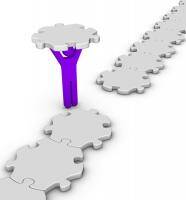Last week, The Economist asked Cameron Marlow, Facebook’s in-house sociologist, to run some stats on the average number of friends a Facebook user has and how often they communicate with them. According to existing theory, the human brain limits social groups to about 150 (called the Dunbar number). Does this hold up when we look at the size of social groups on Facebook?
According to Dr Marlow, the average number of friends in a Facebook network is 120, which seems in the right range. Dr Marlow went further, and came up with some interesting stats about those groups: for example, the average man interacts with just seven of those friends, while the average woman interacts with ten. I’ll leave it to the sociologists to extrapolate what that might mean, but it did strike me as interesting that aggregated analysis of the Facebook data set can shed light on some pretty interesting questions in all sorts of fields.
But what about going beyond passive analysis of social network data? What about experiments?
Last week, The Economist asked Cameron Marlow, Facebook’s in-house sociologist, to run some stats on the average number of friends a Facebook user has and how often they communicate with them. According to existing theory, the human brain limits social groups to about 150 (called the Dunbar number). Does this hold up when we look at the size of social groups on Facebook?
According to Dr Marlow, the average number of friends in a Facebook network is 120, which seems in the right range. Dr Marlow went further, and came up with some interesting stats about those groups: for example, the average man interacts with just seven of those friends, while the average woman interacts with ten. I’ll leave it to the sociologists to extrapolate what that might mean, but it did strike me as interesting that aggregated analysis of the Facebook data set can shed light on some pretty interesting questions in all sorts of fields.
But what about going beyond passive analysis of social network data? What about experiments?
We know
Facebook uses R now to analyze experiments, and I’m pretty sure experiments are conducted already with advertising: show ad A to a sample of 1,000 prospects, show ad B to a matched sample of another 1000, and you can answer a lot of interesting questions. Which ad is more successful overall (as measured in clicks)?. What demographic qualities, social connections, or online behavior of the user makes an ad more or less successful?
But it’s intriguing to think of the possibilities in extending these experiments beyond marketing into scientific domains. Behavioral psychology is a field that immediately comes to mind: rather than running behavioral experiments on broke grad students in a lab, what about selecting a sample of active users on Facebook and running the experiment via an app? (Added bonus: the conclusions of the experiment apply to a broader group than just broke grad students, unlike most behavioral psychology studies these days.) And given the enormous size of Facebook’s user base —
more than 50 million users in North America alone — perhaps this concept could even be extended into behavioral economics to get information on some of the pressing questions of the day. If the stimulus checks were handed out via Facebook rather than by the IRS, we could maybe get some real information about whether they actually
stimulate the economy?Of course, for any of this to happen Facebook would have to allow independent researchers access to their users and data, and Facebook users are rightly concerned about their privacy. In fact, Facebook recently announced that it is now asking their users for
input on how their data should be used. In the same way that drivers are asked whether their organs can be made available for transplant in the event of a fatal accident, perhaps Facebook should be asking their users if they want to make their social data available to science.






